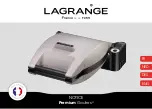38
ESL User Manual
</EslTemplate>
</EslLayoutInfo>
The desired image will be generated by parsing the template from top to bottom, so if one
object needs to be drawn on top of another, then this can be done by changing the sequence
of the objects in the image template.
The
“Variant”
field specifies the hardware variant of the ESL for each template. Multiple
templates can be added if more than one hardware variant is used.
The dynamic content of texts, barcodes and images can be inserted into your template from
the CSV database. To add a certain field from a CSV record to your image, add the number of
the target field into the template between the two
“%”
characters in the content field of the
object.
For example, if the CSV file has the following field sequence
<Modification code>;<Barcode>;<Unique
ID>;<Price>;<Description>;<Weight>;<Unit>;
(and so on), then the
Price
field would be added by using “
%3%”,
since it is field number
3
(starting from
Modification code
, which is field number
0
).
Combining multiple fields as dynamic content is also allowed.
An example of adding dynamic content (e.g., adding weight plus a standard unit) would be:
<Content>Weight: %5% %6%</Content>
Special characters can be added using the standard XML notation. For instance a “&” sign can
be added using:
&
(since its Unicode is U+0026)
Any type of object can be added to the template conditionally if needed, meaning that it is only
shown in the resulting image if a certain field in a CSV record contains a value or equals a
certain value.
This is can be done by adding one of the following lines to any type of object.
<!-- Object if only displayed if field 'x' contains a value -->
<Condition>%x%</Condition>
<!-- Object if only displayed if field 'x' equals 'y' -->
<Condition>%x%=y</Condition>
The following sections will describe the 5 types of object in more detail.


















